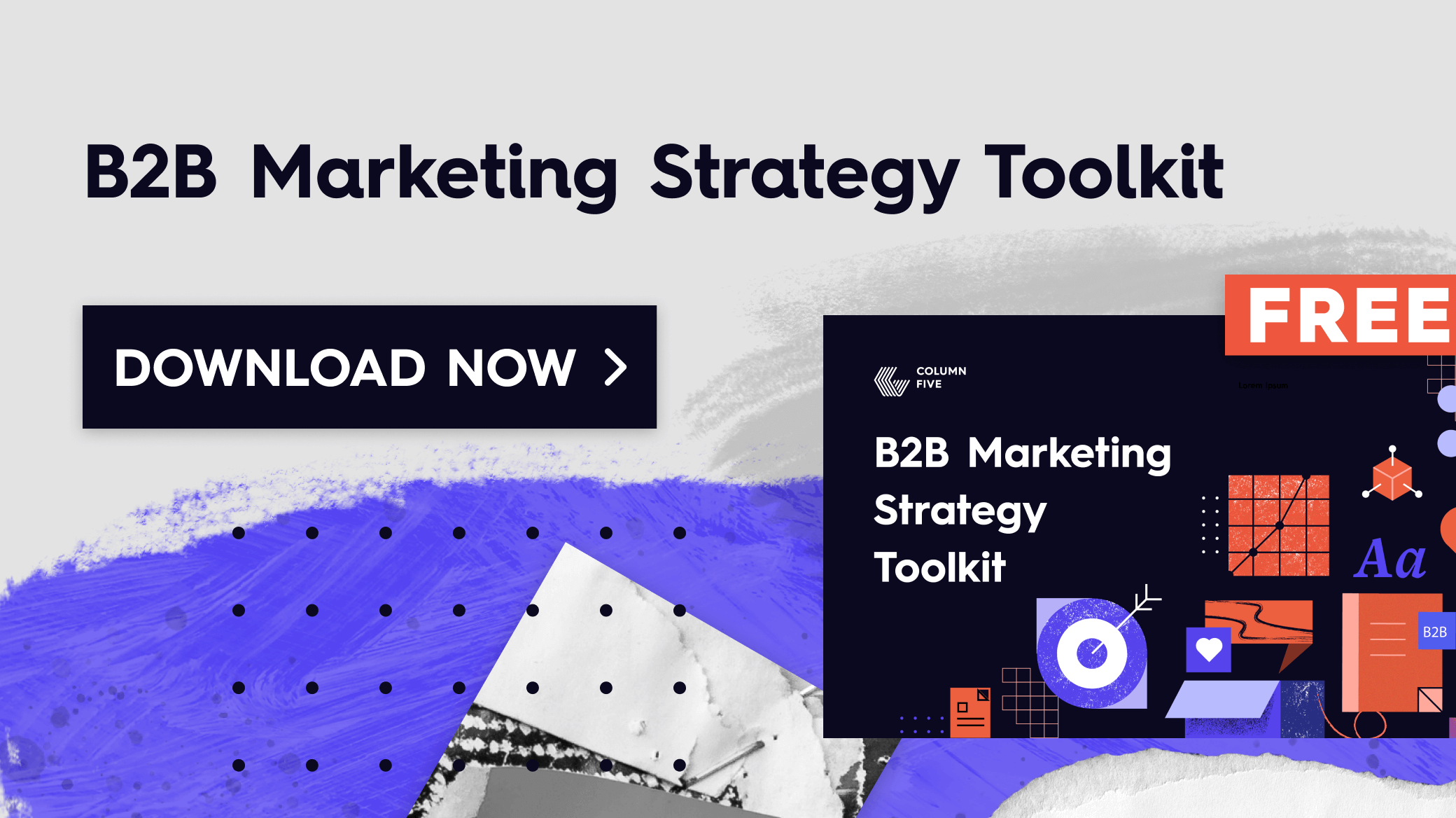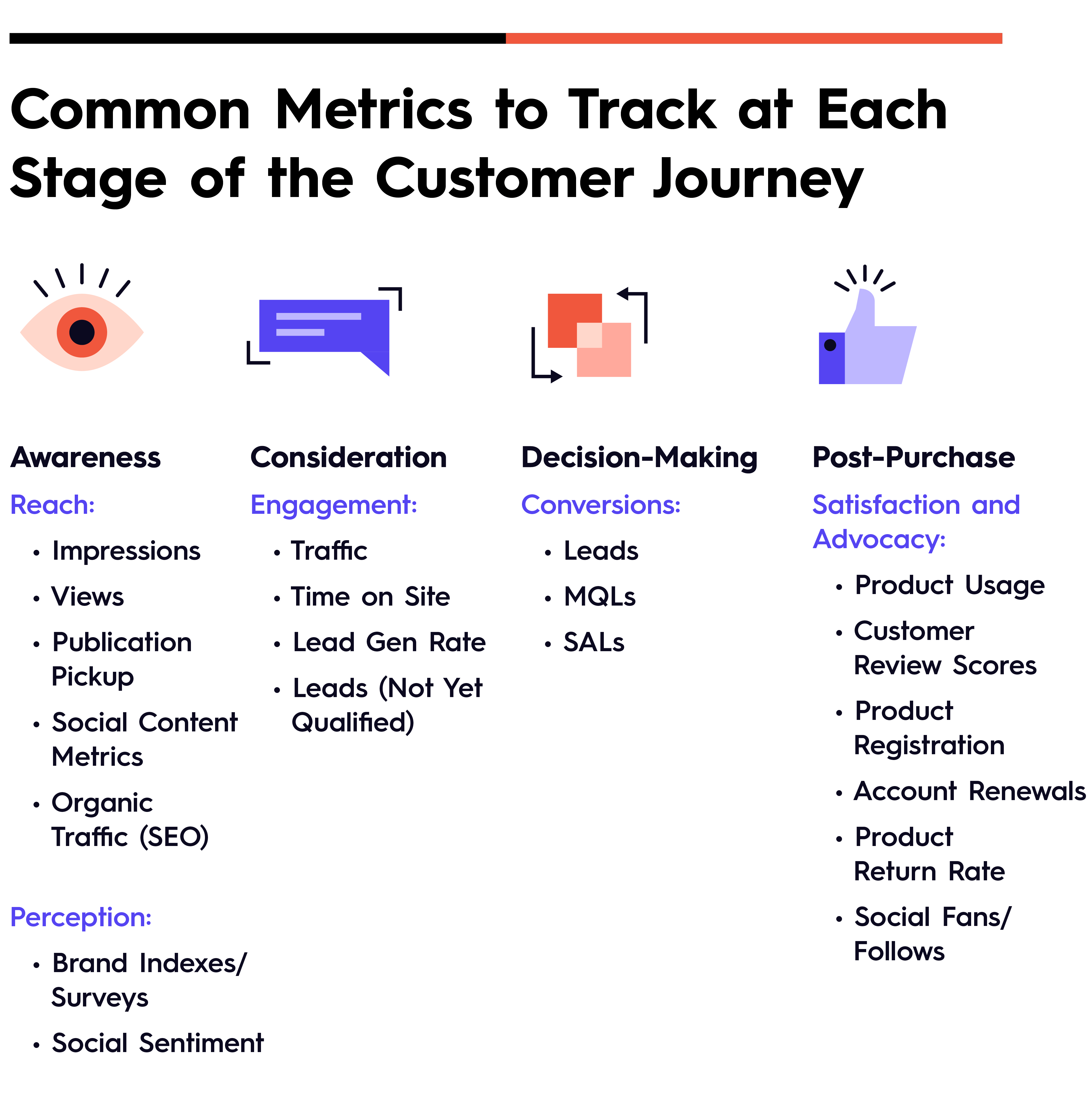Ah, ROI, our old friend (and sometimes enemy). ROI is often the most frustrating part of marketing, yet it’s also the most important—especially if you’re a marketer worried about job security. And while the Internet touts all sorts of formulas and calculators, there isn’t one single metric every brand should use to determine ROI.
Every brand has different needs, different strategies, and different tactics, so a one-size-fits-all approach to calculating ROI is overly simplistic (especially if you’re producing omnichannel campaigns). So how do you figure it out for your own organization? You’ve come to the right place. Here, we’ll walk you through the simple steps you can take to calculate the ROI of your b2b marketing—and avoid the most common mistakes we see when it comes to ROI.

What Are the Biggest Barriers to Calculating ROI?
There are a few common ROI problems we encounter with our clients. They mostly fall under three main categories:
- Lack of preparation (e.g., measurement is an afterthought)
- Lack of knowledge (e.g., baseline information, benchmarks, etc.)
- Lack of tools (e.g., no infrastructure setup)
These can all hinder your ability to calculate ROI, but the truth is that there is an even bigger (and more common mistake) we see our clients make—and that is not calculating ROI at all. The good news? If you’re reading this guide, you’re already doing better than a lot of marketers out there.
64% of B2B marketers say their organization’s ability to demonstrate content marketing ROI is average or worse.
—Content Marketing Institute’s 2022 B2B Content Marketing Report
How Do You Measure the ROI of B2B Marketing?
No matter what product or service you sell, the key to calculating ROI successfully is approaching ROI as an integral part of your content strategy—not as an afterthought. That means knowing what/how you’re going to measure, measuring the right things, and using the results to inform your next move. To help you do that, we’ve laid out the same process we use to help our clients calculate ROI—and improve it with every campaign.
1) Set concrete goals.
It may seem obvious, but this is actually one of the biggest mistakes we see in B2B marketing. Without clear goals, the rest of your strategy crumbles. Spend time on goal-setting (and include the right stakeholders in these conversations) to clearly define what you’re trying to achieve and identify the best measurement approach to track your success.
The more clear your goals are, the easier it will be to calculate ROI.
Some things to keep in mind while you’re setting goals:
- Be specific. ”Building brand awareness” sounds like a goal, but it’s actually a very murky idea that is difficult to measure. What does building brand awareness actually look like to you? Website visits? Video views? Ebook downloads? If you want to calculate ROI accurately, you need something concrete to measure. Often, several quantitative goals contribute to a larger qualitative goal (e.g., relationship-building), but it’s the quantitative goals that will help you better calculate ROI.
- Consider the timeframe. ROI does not show up overnight. It probably won’t show up in a few weeks. Marketing ROI is all about the long haul, so think about how that may factor into your goal.
Note: Make sure all stakeholders have signed off on your stated goals. Going forward, you need everyone on the same page to set yourself up for success.
2) Choose the right metrics.
Calculating your ROI is all about accuracy and relevancy. Just because you can measure something—and the numbers may even seem exciting—doesn’t mean it’s the right thing to measure.
For example, while impressions can be a useful metric to show your reach if it’s conversions you’re after, impressions may just be a vanity metric. Sure, it may seem exciting that a million people saw your YouTube thumbnail, but it also means that a million people saw it and scrolled past it.
Remember: The biggest number doesn’t always mean the best results.
Look at your goals, and identify the most relevant metrics to measure them.

3) Set your budget.
Figuring out how much to invest in your B2B marketing is always tricky, but it is usually dictated by your historical data. For this, there are a few numbers you need to know.
Lead Value (LV): How much a lead is historically worth.
LEAD VALUE FORMULA
Average Customer Lifetime Value x Close Rate
Example
$50,000 (ACLV) x .04% (CR) = $2,000 LV
Cost Per Lead (CPL): How much it costs to acquire a lead.
COST PER LEAD FORMULA
Total Marketing Spend / Number of New Leads
Example
$5,000 (TMS) / 10 leads (NL) = $500 CPL
Note: If you’re a brand-new company and you don’t know your CPL, you may want to work backward from your average Click Through Rate (CTL).
CLICK THROUGH RATE FORMULA
Clicks / Impressions
Example
10 (Clicks) / 100 (Impressions) = 0.1% CTR
For every campaign, determine how many leads you want to acquire and then identify your target CPL. This should be lower than your historical CPL. (If you use your current CPL, you won’t technically make a “profit” on any new leads—you’ll just break even.)
Do you have a distribution plan? Determine how you will allocate your budget across channels before you launch any campaigns.
4) Set up your measurement infrastructure.
If you don’t have the tools and infrastructure in place to actually measure the things you want to, no amount of planning or strategizing will help you. Once you know what you plan to measure (and how much you plan to spend), make sure you have the tools set up to actually track it.
- Do you have all of your tracking codes and pixels placed where you need to?
- If you’re using keyword-tracking software, you’ll want to start tracking the keywords before beginning your campaigns. (Some tools don’t pull historical data, so your progress is impossible to measure.)
- Are all of your tools talking to each other? For example, do you have Google Search Console, Google My Business, and Google Analytics? Sometimes each of these requires a separate integration into any other tracking system you might be using.
- Are you using an ESP that allows you to properly track all of the behaviors you want? For example, some email service providers only tell you if a subscriber opened your email. Others tell you if they glanced at it, scrolled through, or thoroughly read it.
- Are you relying on automation for all of your data presentation? If so, you’ll want to spot check that it’s pulling the right numbers into the right places.
- Do you have someone who owns all of the data collection and presentation? (Team infrastructure is important to ensure there aren’t miscommunications or data left uncollected.)
Double-check everything! There is nothing more frustrating than being sabotaged by a broken link.
5) Test, test, test.
It’s very important to develop—and document—hypotheses before launching a campaign. We often think we know how things will perform, but it’s only when we see the plan on paper (and document the results) that we can really learn and improve.
That said, before you sink all your money into one thing, it’s smart to use a portion of your budget for testing. A testing period will help you 1) ensure that things are up and running correctly and 2) show you what is and isn’t working (or what could be working better). This is a surefire way to improve your ROI without wasting a ton of money off the bat.
5) Monitor and report.
While your measurement approach is unique to each campaign, to calculate the success of your B2B marketing in terms of dollars and cents, the formula is simple.
ROI FORMULA
[Return – Investment] / Investment
x 100
Example
Let’s say you spend $5,000 on a campaign that generated 5 leads, and your Average Customer Lifetime Value is $50,000.
$250,000 Return (5 Leads x $50,000) – $5,000 Investment = $245,000
$245,000 (Return – Investment) / $5,000 (Investment) = 49
49 x 100 = 4,900% ROI
Of course, that is your high-level number. You can go even more granular in your calculation. To do that, here are a few calculator tools that may help:
What matters most in reporting ROI is not only the number you end up with but the insights you learned. Take the time to dig into the data and process the findings.
- Was your original hypothesis correct?
- What was particularly successful?
- What was notably unsuccessful?
The more you critically analyze your results, the more you can improve next time around.
How to Improve Your ROI
No matter how successful you are in your B2B marketing, there is always room to grow. A few things to keep in mind as you continue to refine your strategy:
- Don’t get tunnel vision. It’s important to start out with a hypothesis, but don’t double-down on the thing you think you want when the data may show something else entirely. For example, you may have wanted a viral hit on YouTube (and failed). But if the data shows that your Instagram story conversion rate was astronomical compared to YouTube, you’ll see that’s where you should put your money next time.
- Expect the unexpected. Many marketers get discouraged if they don’t get the results they were expecting. (Even if the results are good, you can take an ego hit if the results aren’t what you wanted.) Just know it’s all part of the learning process. Be brave and humble enough to tweak, test, and grow.
- Look for missed opportunities. If you’ve tried everything you can think of and you’re still struggling to get the ROI you want, it may be time to go back to basics. Conduct a content audit to assess your own content, as well as your competitors’ content, and identify opportunities to improve, messaging gaps, etc. You may also want to re-map your customer journey to ensure you’re giving people the right messages at the right time.
Most importantly, don’t become complacent. If you’re struggling with lackluster results, consider bringing in some extra support to get your marketing in shape. If you’re on the hunt for an agency partner, start with our tips to find a B2B content agency with the right expertise, or find out what it’s like to work with us. Above all, remember: B2B marketing isn’t always about being the best. It’s about being the best at experimenting, evaluating, and tweaking your approach.





